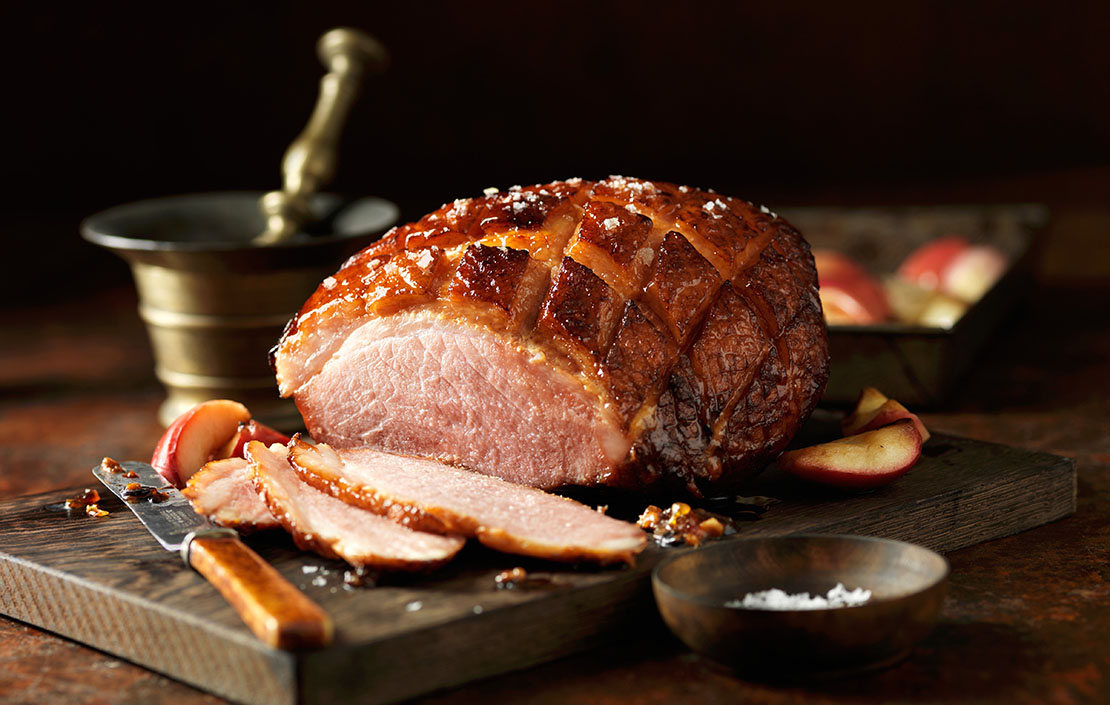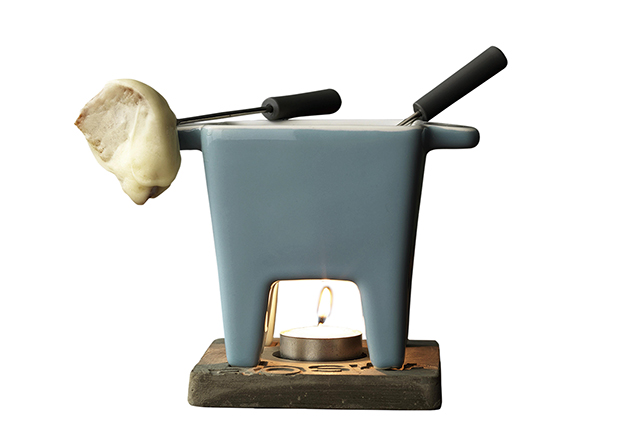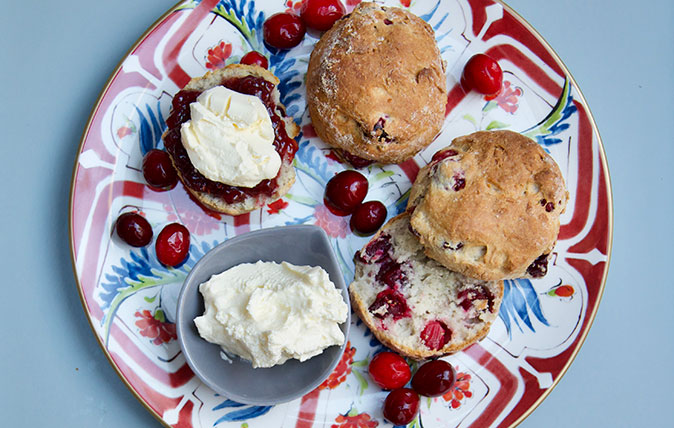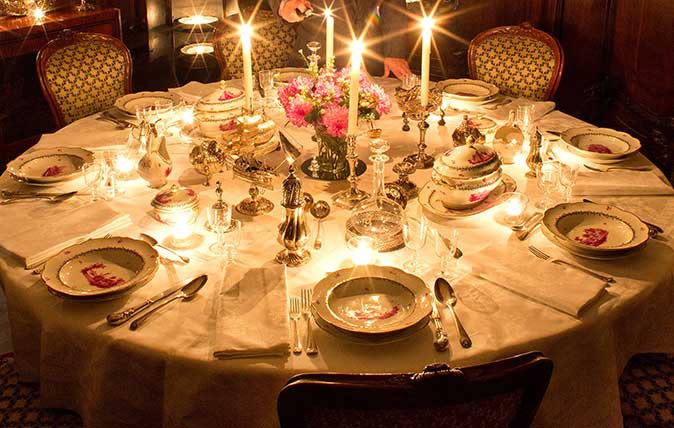How ham can be the real show-stopper of the Christmas table and where to find your one this year
At once sumptuous yet simple, a ham is an age-old tradition that for many is the real highlight of the Christmas feasting. Flora Watkins digs in.


For some, Christmas doesn’t really get under way until Carols from King’s and the first strains of Once in Royal David’s City on the wireless. However, for Neale Hollingsworth of Dukeshill Ham in Shropshire, the festivities begin a week earlier, when he loads up his car to make a very special delivery.
‘I always know that Christmas has arrived because I personally take The Queen’s hams to Sandringham,’ Mr Hollingsworth divulges. Since receiving the Royal Warrant in 2003, ‘it’s become a bit of a tradition’.
Around the country, from royal households to the more humble, Christmas hams, in their glazed and clove-studded Dickensian glory, are central to the festivities – and have been for centuries. Ham has been used as feast food since the time of the Romans, explains writer and food historian Kate Colquhoun, author of Taste: The Story of Britain Through Its Cooking (Bloomsbury, £12.99): ‘Apicius has recipes for boiled and spiced honeyed hams and “pig” is an Anglo-Saxon word. This was a celebratory food that could be enjoyed by rich and poor alike. ‘Other meat was expensive, but a pig was the thing that nearly every peasant had,’ notes Miss Colquhoun. ‘They’d put it in the wood in the autumn, to forage on beech nuts, slaughter it and preserve it to have meat through the winter.’
Hogs would be killed at Michaelmas and made into sausages and black pudding, with flitches of bacon hung in the chimney to smoke by the fire. When the time came to eat the hams, they would be boiled, then dressed according to fashion and status.
"Tom Parker Bowles will glaze his ham with marmalade and stud it with cloves for 'that taste of Christmas'"
Mustard seed was what peasants had access to, but, for the rich, hams could be ‘carriers of fashion’, according to Miss Colquhoun. They would have been decorated with spices in the Middle Ages and, in the Tudor period, oranges, which were fashionable and new.
In her Book of Household Management, published in 1861, Mrs Beeton gives a recipe for ham that’s familiar to many of us. Readers are advised to simmer it with vegetables and herbs, then strip off the skin and ‘sprinkle over bread-raspings, or, if wanted particularly nice, glaze it’.
Food writer Tom Parker Bowles will glaze his ham with marmalade and stud it with cloves for ‘that taste of Christmas’. ‘There’s a fashion now for Pata Negra, which is wonderful, but, at this time of year, what you want is a whole [traditional] ham, kept in the larder,’ he stresses. ‘You can have it with eggs for breakfast or with a baked potato for lunch. I can’t walk past the room it’s in without a knife.’
Exquisite houses, the beauty of Nature, and how to get the most from your life, straight to your inbox.
Mr Hollingsworth concurs that this is one of the great joys of a festive ham: ‘It’s such a stalwart over the Christmas period – if you’ve got one in the fridge, you know that every meal is sorted, whether it’s people popping in for drinks or unexpected guests.’
With a large ham, he continues, you’ll be ‘picking at it until Twelfth Night’ – apart, that is, from the year when labrador Sidney found it cooling on a table in the garden. This necessitated a swift trip back to Dukeshill HQ to pick up more and Sidney spent December 28 at the vet’s, having his stomach pumped.
Sidney’s nemesis was a Wiltshire ham, the company’s bestseller. Cured in a brine of water, salt and a little sugar for several days, the meat is then kept for another week for the flavour to develop, before being cooked.
The singular taste of the Suffolk black hams made by Emmett’s of Peasenhall in Suffolk that caught the attention of the Queen Mother. Emmett’s, which is now owned by former Harrods food manager Mark Thomas, supplied Her Majesty for 36 years.
‘The only tweak I’ve made was to change the beer they’re marinated in from Guinness to Nethergate Suffolk black porter,’ says Mr Thomas, as he turns the gammons – they have to be rotated every day for six weeks, by hand. ‘I don’t go to the gym – I lift hams,’ he chuckles. Afterwards, they are smoked for a month, then simmered gently for some 12 hours.
There’s ‘no need for a glaze because they have so much flavour,’ Mr Thomas explains. It’s a testament to that flavour that the vegan girlfriend of his brother felt compelled to try some of the black ham when she came to the shop. OBEs have been awarded for less.
Like the Bradenham, another traditional British treat, York ham, had all but disappeared until it was resurrected by artisan producers, including Dukeshill. This dry-cured ham, a little saltier than the Wiltshire, is the original source of the company’s Royal Warrant.
York ham may no longer be produced in that city, but, on the edge of the Yorkshire Dales, Lishman’s of Ilkley produces a honey-mustard Yorkshire ham that can be eaten cold or hot.
‘If I have my way – and I shan’t, my Christmas Day eating would consist of an omelette and cold ham,’ wrote the doyenne of food writers, Elizabeth David. She may have had her own Barbados Baked and Glazed Gammon in mind (a glaze of soft brown sugar, mustard and milk). However, whether boiled or baked, cooked in Coca-Cola, à la Nigella, or ginger beer, as Sarah Hollingsworth, wife of Neale, prefers, there’s no doubt that many are in sympathy with Miss David.
‘I could do without the turkey – horrible Victorian arriviste! – and the mince pies, but, for me, it wouldn’t be Christmas without the ham,’ grumbles Mr Parker-Bowles. Whereas the main component of Christmas lunch itself might have changed from beef (as 18th-century parson James Woodforde enjoyed in his Diary of a Country Parson) to goose or turkey – popularised by Dickens in A Christmas Carol – ham is a constant.
‘I really don’t know why I don’t have one for the rest of the year, because I do love ham,’ muses Mr Parker Bowles. Year-round ham? Now, that really is something to celebrate.
Best hams to buy
- Whole bone-in Wiltshire ham (minimum 4.8kg (10½lb)), £87, Dukeshill.
- Wiltshire-cure roasted ham on the bone (2.5kg (5½lb)), £50, Waitrose.
- Whole Suffolk black ham on the bone (7.5kg (16½lb)), £185.63, Emmett’s.
- Honey-mustard Yorkshire ham (4kg (9lb)), £66, Lishman’s of Ilkley.
Christmas drinks gift guide: Best gin, best whisky, beer and more for the festive season
Whether you're keen to pour your own draft beer, drink Cotswolds whisky or enjoy a raft of different gins, we've

Christmas presents for foodies
These Christmas presents are perfect for the foody in your life

Credit: Melanie Johnson
How to make cranberry scones for a cream tea with a Christmas twist
You might think of scones as something for sunny summer afternoons – this recipe will change that.

Credit: Alamy
Five tips to make sure that your dinner party is remembered for all the right reasons
While dinner parties at this time of year promise to be festive occasions, they can be a minefield of etiquette
